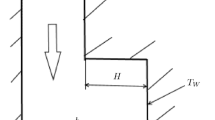Abstract
A model experiment for the study of evaporating turbulent two-phase flows is presented here. The study focuses on a situation where pre-atomized and dispersed droplets vaporize and mix in a heated turbulent flow. The test bench consists in a channel flow with characteristics of homogeneous and isotropic turbulence where fluctuations levels reach very high values (25% in the established zone). An ultrasonic atomizer allows the injection of a mist of small droplets of acetone in the carrier flow. The large range diameters ensure that every kind of droplet behavior with regards to turbulence is possible. Instantaneous concentration fields of the vaporized phase are extracted from fluorescent images (PLIF) of the two phase flow. The evolution of the mixing of the acetone vapor is analyzed for two different liquid mass loadings. Despite the high turbulence levels, concentration fluctuations remain significant, indicating that air and acetone vapor are not fully mixed far from the injector.














Similar content being viewed by others
Abbreviations
- C :
-
Vapor concentration (kg m−3)
- C ref :
-
Reference concentration (kg m−3)
- C vap :
-
Vapor mass concentration (kg m−3)
- D 10 :
-
Mean arithmetic diameter (m)
- D 32 :
-
Sauter mean diameter (m)
- f, g :
-
Inter-correlation functions
- F u , F v :
-
Longitudinal and radial components flatness factors
- H :
-
Width of the channel cross-section (m)
- L f :
-
Turbulence integral length scale (m)
- M :
-
Molar mass (kg m−1)
- m :
-
Mass (kg)
- S u , S v :
-
Longitudinal and radial components skewness factors
- St :
-
Stokes number
- T :
-
Temperature (K)
- U 0 :
-
Flowing velocity (m s−1)
- U :
-
Longitudinal velocity (m s−1)
- V :
-
Radial velocity (m s−1)
- u, v :
-
Instantaneous velocities (m s−1)
- u′, v′:
-
Turbulent velocity components (m s−1)
- X :
-
Longitudinal location (m)
- X vap :
-
Vapor molar fraction
- Y :
-
Radial location (m)
- y′:
-
Fluctuating vapor mass fraction
- Y vap :
-
Vapor mass fraction
- \( \overline{( \cdot )} \) :
-
Arithmetic average symbol
References
Abramzon B, Sirignano WA (1989) Droplet vaporization model for spray combustion calculations. Int J Heat Mass Transf 32:1605–1618
Atthasit A (2003) Etude expérimentale des phénomènes d’interaction dans les jets diphasiques denses au moyen de jets rectilignes monodisperses. Phd thesis, ENSAE Toulouse
Bazile R, Stepowski D (1995) Measurements of vaporized and liquid fuel concentration fields in a burning spray jet of acetone using planar laser induced fluorescence. Exp Fluids 20:1–9
Bédat B, Cheng RK (1995) Experimental study of premixed flames in intense isotropic turbulence. Combust Flame 100:485–494
Birouk M, Gökalp I (2006) Current status of droplet evaporation in turbulent flows. Prog Energy Combust 32:408–423
Chiang CH, Sirignano WA (1993) Axisymmetric calculation of three droplets interactions. Atomization Spray 3:91–107
Ferrand V, Bazile R, Borée J, Charnay G (2003) Gas-droplet turbulent velocity correlations and two-phase interaction in an axisymmetric jet laden with partly responsive droplets. Int J Multiphase Flow 29:195–217
Frackowiak B (2007) Approche expérimentale et simulation numérique des effets d’interaction entre gouttes en évaporation. Phd thesis, ENSAE, Toulouse
Hubbard GL, Denny VE, Mills AF (1975) Droplet evaporation: effects of transient and variable properties. Int J Heat Mass Transf 18:1003–1008
Jablonski A (1935) Über den Mechanismus der Photolumineszenz von Farbstoffphosphoren. Zeitschrift für Physik 94:38–46
Karpetis AN, Gomez A (2000) An experimental study of well-defined turbulent non-premixed spray flames. Combust Flame 121:1–23
Kim I, Elgobashi S, Sirignano WA (1993) Three-dimensional flow over two spheres placed side by side. J Fluid Mech 246:465–488
Kurosawa R, Hishida K, Maeda W (2002) Combined measurement of LIF and ILIDS for vapor concentration and droplet size and velocity in a spray. Proc Therm Eng Conf 177:249–278
Lecordier B (1997) Etude de l’interaction de la propagation d’une flamme prémélangée avec le champ aérodynamique par association de la tomographie laser et de la vélocimétrie par image de particules. Phd thesis, Faculté des Sciences de l’Université de Rouen
Lozano A, Yip B, Hanson RK (1992) Acetone, a tracer for concentration measurements in gaseous flows by planar induced fluorescence. Exp Fluids 13:363–376
Maurel S (2001) Etude par imagerie laser de la génération et de la rupture d’un écoulement tourbillonnaire compressé. Phd thesis, Institut National Polytechnique de Toulouse
Orain M, Mercier X, Grisch F (2006) PLIF imaging of fuel-vapor spatial distribution around a monodispersed stream of acetone droplets: comparison with modeling. Combust Sci Technol 177:249–278
Rajaram R, Lieuwen T (2004) Effect of approach flow turbulence characteristics on sound generation from premixed flames. AIAA Paper 2004-0461
Réveillon J, Demoulin FX (2007) Evaporating droplets in turbulent reacting flows. Proc Combust Inst 31:2319–2326
Ritchie BD, Seitzman JM (2001) Quantitative acetone PLIF in two-phase flows. AIAA Paper 2001-0414
Sazhin S (2006) Advanced models of fuel droplet heating and evaporation. Prog Energy Combust 32:162–214
Sirignano WA (1999) Fluid dynamics and transport of droplets and sprays. Cambridge University Press, Cambridge
Sornek RJ, Dobashi R, Hirano T (2000) Effect of turbulence on vaporization, mixing, and combustion of liquid-fuel sprays. Combust Flame 120:479–491
Spalding DB (1951) Combustion of fuel particles. Fuel 30:121
Thurber M, Hanson R (1999) Pressure and composition dependences of acetone laser-induced fluorescence with excitation at 248, 266, and 308 nm. Appl Phys B 69(3):229–240
Videto BD, Santavicca DA (1991) A turbulent flow system for studying turbulent combustion processes. Combust Sci Technol 76:159–164
Acknowledgments
The authors would like to thank F. Moreau and Dr. B. Bédat for fruitful discussions. G. Couteau, M. Marchal, E. Cid (IMFT) and P. Gicquel (ONERA) are greatly acknowledged for technical support.
Author information
Authors and Affiliations
Corresponding author
Rights and permissions
About this article
Cite this article
Cochet, M., Bazile, R., Ferret, B. et al. Evaporation of polydispersed droplets in a highly turbulent channel flow. Exp Fluids 47, 379–394 (2009). https://doi.org/10.1007/s00348-009-0667-9
Received:
Revised:
Accepted:
Published:
Issue Date:
DOI: https://doi.org/10.1007/s00348-009-0667-9




